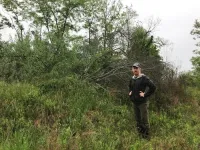(Press-News.org) A team of paleontologists working near Rangely, Colorado, has uncovered a new (or, more accurately, very old) state resident—a fossil mammal about the size of a muskrat that may have scurried through swamps during the Age of Dinosaurs.
The researchers, led by the University of Colorado Boulder’s Jaelyn Eberle, published their findings Oct. 23 in the journal PLOS ONE.
Eberle and her colleagues named their discovery, which they identified from a piece of jawbone and three molar teeth, Heleocola piceanus. The animal lived in Colorado roughly 70 to 75 million years ago—a time when a vast inland sea covered large portions of the American West. (Fittingly, “Heleocola” roughly translates to “swamp dweller” in Latin).
“Colorado is a great place to find fossils, but mammals from this time period tend to be pretty rare,” said Eberle, curator of fossil vertebrates at the CU Museum of Natural History and professor in the Department of Geological Sciences. “So it’s really neat to see this slice of time preserved in Colorado.”
Compared to much larger dinosaurs living at the time like tyrannosaurs or the horned ancestors of Triceratops, the new fossil addition to Colorado might seem tiny and insignificant. But it was surprisingly large for mammals at the time, Eberle said.
She’s also glad to see Rangely, which sits in the northwest corner of the state not far from Dinosaur National Monument, get its due.
“It’s a small town, but, in my experience as a paleontologist, a lot of cool things come out of rural environments,” Eberle said. “It’s nice to see western Colorado have an exciting discovery.”
Land meets water
That cool discovery helps to paint a more complete picture of a Colorado that would be all but unrecognizable to residents today.
Paleontologists John Foster and ReBecca Hunt-Foster, co-authors of the new study, have been coming to this part of the state to dig up fossils every summer for about 15 years. Seventy million years ago, it was a place where land met water. Here, creatures like turtles, duck-billed dinosaurs and giant crocodiles may have flourished in and around marshes and estuaries, gorging themselves on wetland vegetation, fish and more.
“The region might have looked kind of like Louisiana,” said ReBecca Hunt-Foster, a paleontologist at Dinosaur National Monument in Utah and western Colorado. “We see a lot of animals that were living in the water quite happily like sharks, rays and guitarfish.”
John Foster first remembers seeing the bit of mammal jaw emerge from a slab of sandstone that he collected from the site in 2016. The fossil measured about an inch long.
“I said, ‘Holy cow, that’s huge,” said Foster, a scientist at the Utah Field House of Natural History State Park Museum in Vernal, Utah.
One big mammal
Eberle explained that before an asteroid killed off the non-avian dinosaurs 66 million years ago, mammals tended to be small—most were about the size of today’s mice or rats. She largely identifies them from the tiny teeth they left behind.
H. piceanus, in comparison, was positively huge. Eberle estimates that the animal, a cousin to modern-day marsupials, weighed 2 pounds or more, larger than most Late Cretaceous mammals. (It’s not quite a record—another fossil mammal from the same period, known as Didelphodon, may have weighed as much as 11 pounds). Based on H. piceanus’ teeth, the mammal likely dined on plants with a few insects or other small animals mixed in.
While dinosaurs get all the glory, the new find is another reason why paleontologists shouldn’t overlook ancient mammals. Small or not, they played an important role in Colorado’s ecosystems in the Late Cretaceous.
“They’re not all tiny,” Eberle said. “There are a few animals emerging from the Late Cretaceous that are bigger than what we anticipated 20 years ago.”
Hunt-Foster said that the Mountain West is a special place for anyone who loves fossils. She also urged people visiting public lands not to collect vertebrate fossils, such as dinosaurs, they may come across while hiking to avoid disturbing important scientific information. Instead, they should note the location, take a photo and alert a representative from a nearby museum or public land agency.
“We have scientists that come from all over the world specifically to study our fossils,” she said. “We really are lucky.”
END
Paleontologists discover Colorado ‘swamp dweller’ that lived alongside dinosaurs
2024-10-23
ELSE PRESS RELEASES FROM THIS DATE:
Repeated COVID vaccines enhance mucosal immunity against the virus
2024-10-23
Ghent, October 24, 2024 – During the COVID pandemic, many of us have received multiple mRNA vaccines. New work by researchers at the VIB-UGent Center for Inflammation Research, Ghent University, and University Hospital Ghent, among others, has found that such repeated vaccinations lead to the presence of mucosal antibodies, for example, inside the nose. Their work appears in Science Translational Medicine.
Protective booster shots
Part of the global response strategy against the COVID pandemic involves the administration of booster shots, or ‘vaccine updates’ to ensure ...
MD Anderson expands arts experience program to enhance healing and well-being for patients
2024-10-23
HOUSTON ― As part of its ongoing commitment to patient comfort and healing, The University of Texas MD Anderson Cancer Center today announced a new focus on art to support the revitalization and expansion of its clinical facilities. This initiative will include the creation of a multisensory healing environment in both public spaces and patient care areas that are designed to prevent disease, promote health and foster well-being.
This transformative project aims to enhance every aspect of the patient experience, reinforcing MD Anderson's dedication to comprehensive ...
Students at Historically Black Colleges and Universities (HBCUs) face barriers to medical school admission, study finds
2024-10-23
CHAPEL HILL, N.C. – There are 45.3 million African Americans living in the United States and they represent 13.6 percent of the U.S. population, according to the U.S. Census Bureau. But only 5.7 percent of physicians in the United States self-identify as Black, despite multiple efforts over many years to increase the number of Black doctors.
A new study led by Jasmine Weiss, MD, MHS, FAAP, assistant professor of pediatrics in the UNC School of Medicine, describes the barriers to medical school admission that students at Historically Black Colleges and ...
Symbiosis in ancient Corals
2024-10-23
Coral reefs rank among the most biodiverse habitats on Earth and are often referred to as the rainforests of the sea. Modern reef building corals evolved in the Triassic Period around 250 million years ago. They can live in symbiosis with tiny organisms, often algae, that can carry out photosynthesis. This photosymbiosis is particularly beneficial in nutrient-poor waters because it helps the corals to recycle scarce nutrients.
Geological evidence reveals that corals already existed in the Devonian period, over 385 million ...
Researchers receive grant to study invasive autumn olive
2024-10-23
Almost a ubiquitous presence in landscapes across Southwest Virginia, the invasive autumn olive thrives.
But it’s not supposed to be here.
Autumn olive is known for its nitrogen-fixing ability, allowing it to thrive in poor soils and outcompete native plants. The shrub’s berries are edible, rich in antioxidants such as lycopene, and have a tart-sweet flavor. While its berries are beneficial for wildlife, the plant's aggressive spread disrupts local ecosystems, reducing biodiversity.
With a one-year grant from the Powell River ...
New research shows urine tests may detect early diseases
2024-10-23
Early detection is critical when it comes to curing diseases like cancer, but not everyone has easy access to screening tools. For problems in the genitourinary (GU) tract (which includes the kidneys, prostate, and bladder), health providers usually use a combination of screening tools, including blood tests, imaging, and physical examinations. Scientists are now working on an even simpler tool for screening illnesses before they become a problem – urine analysis.
According to a new study from scientists at The University of Texas at Arlington, Chan-Zuckerberg Biohub, and Stanford University, ...
Antibiotics and antifungals may slightly affect Parkinson's risk, study finds
2024-10-23
A Rutgers Health study has found that people who took multiple courses of penicillin antibiotics had a modestly lower risk of developing Parkinson's disease, a surprising finding that researchers say highlights the complex relationship between bacteria in the digestive tract and brain health.
The study, published in Parkinsonism & Related Disorders, analyzed medical records from more than 93,000 people in the United Kingdom. Researchers found that those who received five or more courses of penicillin antibiotics in the five years before diagnosis had about a 15% lower risk of Parkinson's compared with those ...
Nixing narcolepsy nightmares
2024-10-23
Nightmares affect 30-40% of patients with narcolepsy, but are often overlooked
Treatment can transform patients’ sleep and their daytime mood in a matter of weeks
Study found overall reduction in nightmare severity and frequency in six patients
CHICAGO --- A new Northwestern Medicine study has demonstrated a new way to treat narcolepsy-related nightmares.
The scientists combined cognitive behavioral therapy (CBT) and lucid dreaming to help patients in a small clinical trial.
“We had them imagine what they’d like to dream instead of their nightmare, almost like they’re writing a movie script,” said corresponding author ...
Mass General Brigham selected to receive $3.29 million award from ARPA-H’s Sprint for Women’s Health
2024-10-23
Mass General Brigham has been selected by the Advanced Research Projects Agency for Health (ARPA-H) as an awardee of the Sprint for Women’s Health to address critical unmet challenges in women’s health, champion transformative innovations, and tackle health conditions that uniquely or disproportionately affect women. Mass General Brigham will receive $3.29 million in funding over two years through the Sprint for Women’s Health spark track for early-stage research efforts.
Understanding and improving sleep is especially important for women, who face a higher risk of neurodegenerative diseases ...
The decision to eat may come down to these three neurons
2024-10-23
Speaking, singing, coughing, laughing, yelling, yawning, chewing—we use our jaws for many purposes. Each action requires a complex coordination of muscles whose activity is managed by neurons in the brain.
But it turns out that the neural circuit behind the jaw movement most essential to survival—eating—is surprisingly simple, as researchers from Rockefeller University recently described in a new paper in Nature. Christin Kosse and other scientists from the Laboratory of Molecular Genetics, headed by Jeffrey M. Friedman, have identified a three-neuron circuit that connects a hunger-signaling hormone to the jaw movements of chewing. ...



